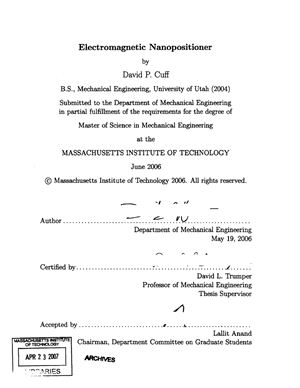Massachusetts Institute of Technology 2006. - 200 p.
This thesis presents the analysis, design, and control of a new class of magnetic nanopositioner. Applications for this class of positioner include sample positioning for scanning microscopy and interferometry, nanofabrication, vibration cancellation, biological cell tracking/positioning, and beam focusing/steering. The nanometer-resolution positioning required in these applications is often provided using piezoelec-tric ceramic actuators. The drawbacks to using piezoelectric actuators include high hysteretic heating, lightly damped structural resonances, the need for preload on the actuator stack, as well as the requirement for a high voltage amplifier.
This thesis demonstrates an electromagnetically driven nanopositioner that is sus-pended on rubber bearings as a promising, low cost alteative to the piezoelectric nanopositioners. Several key features of the electromagnetic nanopositioner are the flux-steering actuator that applies a force linear in both coil current and displace-ment, replacement of the conventional metal flexures with rubber bearings, as well as power and sense electronics that can be easily integrated into a compact package. A prototype of this class of nanopositioner with lOOfim of travel and a maximum force output of 460 N was built and tested. A closed-loop bandwidth of 580 Hz was obtained using capacitance distance sensor feedback.
This thesis presents the analysis, design, and control of a new class of magnetic nanopositioner. Applications for this class of positioner include sample positioning for scanning microscopy and interferometry, nanofabrication, vibration cancellation, biological cell tracking/positioning, and beam focusing/steering. The nanometer-resolution positioning required in these applications is often provided using piezoelec-tric ceramic actuators. The drawbacks to using piezoelectric actuators include high hysteretic heating, lightly damped structural resonances, the need for preload on the actuator stack, as well as the requirement for a high voltage amplifier.
This thesis demonstrates an electromagnetically driven nanopositioner that is sus-pended on rubber bearings as a promising, low cost alteative to the piezoelectric nanopositioners. Several key features of the electromagnetic nanopositioner are the flux-steering actuator that applies a force linear in both coil current and displace-ment, replacement of the conventional metal flexures with rubber bearings, as well as power and sense electronics that can be easily integrated into a compact package. A prototype of this class of nanopositioner with lOOfim of travel and a maximum force output of 460 N was built and tested. A closed-loop bandwidth of 580 Hz was obtained using capacitance distance sensor feedback.

